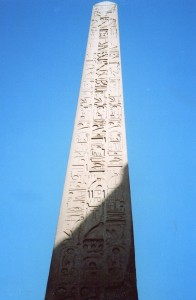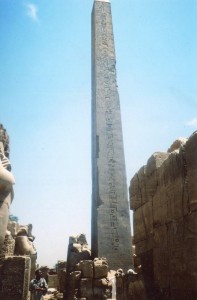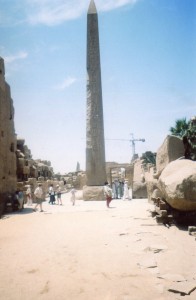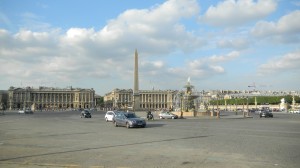To this day, scholars aren’t sure how ancient Egyptians raised obelisks. There are well-educated surmises though.
The most plausible ways required an enormous amount of effort, so obelisks had a lot of meaning for ancient Egyptians. Many Western cultures have also given them central importance. The Washington Monument is in the form of an obelisk. The obelisk is one of the West’s oldest monumental art forms, with some of the most continuity. So we’ll explore some of the most plausible ideas about its meaning and construction.
1. Obelisks were first built around the time the sun cult of Re became central in Heliopolis in the 4th Dynasty. So, ancient Egyptians were erecting obelisks around the time when they were building the pyramids at Giza.
2. Obelisks at that time were much shorter and squatter than the skyscrapers that New Kingdom (1550-1070 BCE) pharaohs built. The Ramesses II (1290-1224 BCE) obelisk in the above shot at the Luxor Temple is 82 feet high. But,
Queen Hatshepsut’s (1473-1458 BCE) obelisk at the Karnak Temple soars to 97 feet. The tallest obelisk is the Thutmose III obelisk in Rome–105 feet.
3. So, like pyramid building, obelisk making evolved over a long period. The first really tall obelisk was built by the Middle Kingdom pharaoh Senusret I (1971-1926BCE, 12th Dynasty; also known as Sesostris I) at Heliopolis–65 feet. It was cut as a single block of Aswan red granite. So, ancient Egyptians perfected this art form over a period of more than 1,000 years. What in the world did it mean to them?
4. Ancient Egyptians didn’t write a full explanation down, so we can only surmise. Stephen Quirke, in The Cult of Ra, writes that obelisks were mainly associated with the sun–they emerged in Heliopolis at the time when the sun cult became central. But he feels that they might have had phallic meanings too, and that Egyptians associated both ideas–both are full of creative power. But he notes that the ancient Egyptian word for obelisk, tekhen, didn’t specifically refer to the sun or the phallus. So obelisks might have had an even larger range of meanings.
But other scholars have also written about their solar meanings. Richard H. Wilkinson, in The Complete Temples of Ancient Egypt, wrote that they were often raised in pairs before temples’ entrances in the 18th and 19th dynasties, and that they were the first and last points of the temple to catch the rays of the rising and setting sun.
5. Obelisks were closely associated with pharaohs–they, and not temple priests, were the ones who built them.
6. How were obelisks erected? Wilkinson noted that Egyptians might have preferred different construction methods at different times. But obelisks were probably pulled up artificial ramps, bottom first, with ropes, and lowered onto their bases. How was a single block of stone 100 feet high so accurately positioned without breaking? We don’t have any writings from Ancient Egypt that explain it. Wilkinson wrote that an artificial ditch could have been created, with the obelisk’s base in the middle. People could have filled the ditch with sand, and several men could have pulled ropes from many directions to carefully guide the monument. This is only a maybe. Ancient Egyptian ingenuity is a hell yes!
7. Obelisks have continued to have central meaning in Western culture. The Assyrian king Ashurbanipal brought two to Nineveh. Roman emperors took several to Rome and Constantinople. Modern Western countries have continued to make political and artistic statements by hauling them to their cities, including Paris, London and New York–it seems that a world-class city has to have an ancient Egyptian obelisk to signify its status. Most ancient Egytian obelisks now stand outside of their homeland.
8. The continuity of the obelisk in Western culture is a fascinating contrast with the most prestigious columns in Chinese culture. The columns on the Confucian Temple in Qufu were made according to ideas of holistic flow of energies. But the obelisk form complements pyramids’s forms–both represent nature’s most creative powers and the sun’s permanence with a simple, abstract form. Ancient Greek temples were later made according to simple and abstract forms too. Both types of building reinforced Westerner’s assumptions that simple and abstract forms embody the most basic truths. The flowing pillars in the Confucian Temple are easily associated with other ancient Chinese ideas, including yin/yang.
9. So an art form is treated as basic within an infinitely multidimensional cultural landscape. The obelisk form expresses truth in the Western heritage, and the Confucian Temple’s columns are most meaningful according to Chinese aesthetics. What seems most basic actually reflects an infinitely rich cultural background.





{ 2 comments }
why did Europe import the obelisks yet they were not part of their culture? I have witnessed an obelisk in Vatican, yet the structures have been associated with paganism and other gods worship. what are the implications?
Importing obelisks is a European tradition that goes back to antiquity. Augustus Caesar erected one at his altar of peace in the city of Rome. The Roman Empire had just conquered Egypt; Augustus was appropriating its icons to show its own universal rule. It’s ironic that the place it was re-erected on was called the altar of peace, but Augustus was a master propagandist.
Since then, European rulers have often had complex feelings regarding Egypt. They had a great deal of respect for it, but they also felt the need to assert themselves over a civilization that they felt was alien. They thus often appropriated its artistic works without fully appreciating the rich contexts that they were created in, and used them to bolster their own identities.
Comments on this entry are closed.